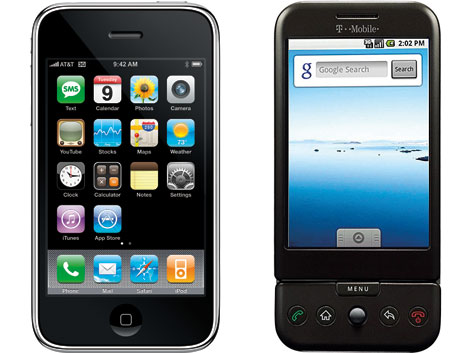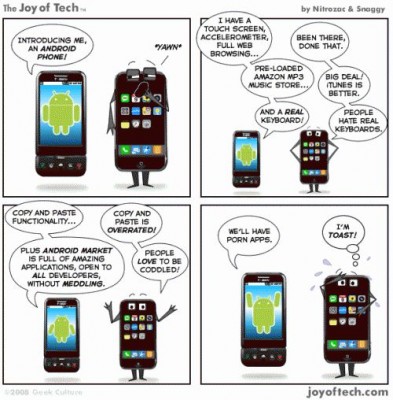iPhone vs G1
 The iPhone obviously had a huge impact on the smartphone market selling over 1MM phones on its opening weekend, but on top of that it also created buzz on the smartphone market and all those people who also wanted a smartphone but not necessarily an iPhone or switching to AT&T are looking around for alternatives… Blackberry stock doubled, Verizon came out with the Voyager, and now T-Mobile with the G1. So would the G1 compete with the iPhone? Experts say that the G1 will sell 400,000 phones before the end of the year … not an impressive number, but then again, t mobile is tiny compared to AT&T. The main difference with Android and the iPhone, and that Android has all its numbers combined – all carriers, all brands, all models – and the iPhone is just one.
The iPhone obviously had a huge impact on the smartphone market selling over 1MM phones on its opening weekend, but on top of that it also created buzz on the smartphone market and all those people who also wanted a smartphone but not necessarily an iPhone or switching to AT&T are looking around for alternatives… Blackberry stock doubled, Verizon came out with the Voyager, and now T-Mobile with the G1. So would the G1 compete with the iPhone? Experts say that the G1 will sell 400,000 phones before the end of the year … not an impressive number, but then again, t mobile is tiny compared to AT&T. The main difference with Android and the iPhone, and that Android has all its numbers combined – all carriers, all brands, all models – and the iPhone is just one.
**5 G1 Pros **
1. Keyboard As proficient as we’ve become with the iPhone’s virtual keypad, tapping touchscreen keys has its limits. Physical keyboards, like those on BlackBerrys and Treos, are much easier to use. The G1’s little keyboard will become especially important as smartphone manufacturers increasingly market their devices as pocket-based PCs, and may give the G1 a clear edge when it comes to gaming.
2. Expandable and Removable Parts The iPhone’s sealed battery is more of a metaphoric problem than a functional one. Sure, it’s a pain not being able to swap in a new battery for long jaunts off the grid (thankfully, plenty of accessories are designed to fix this problem), and nobody likes having to ship his phone back to Apple if his battery begins to lose its charge. But this problem has drawn as much fire as it has because it is symbolic of the closed, unmodifiable nature of Apple products.
3. Integrated Compass Not only does the G1 have GPS, it has an integrated compass that can determine which way you’re facing and give you Google Maps StreetView images of the buildings around you. It’s not that useful on its own; after all, you could just look up to see what’s around you, but we’re interested in seeing what third-party developers can do with this functionality.
4. Offline Integration with Google Apps You can access mobile versions of most Google applications on an iPhone, but with a few exceptions (such as the Google Maps application) you’ll need to do it through the Web. The Android phone’s calendar is an offline version of the much-loved Google Calendar online application. Enter dates into your phone, and they automatically show up on your online calendar. And while you can easily set an iPhone to sync up with calendars such as Google’s there is a beautiful simplicity with the way Android replicates the online programs you are used to offline, in areas where you don’t have service.
5. Multitasking and Copy and Pasting The iPhone can do a lot, but it can’t do a lot at once. With the exception of the iPod music-playing program, which can run in the background while you do just about anything. This does not mean that the iPhone does not multitask, it does, but Apple does not want 3rd party apps killing the battery. With Android, you can easily swipe between programs. However, it must be noted that it is still to be seen what sort of effect this will have on the phone’s memory and performance (point to Apple or Google?) It must be noted that we really do appreciate that Android allows you to copy and paste text. Perhaps it will motivate Apple to finally bring that feature to the iPhone.
**5 iPhone pros **
1. The G1 does not have a Real Media Player The iPhone doesn’t just play back video—it’s one of the best (and best-looking) portable media players on the market. While we’ll certainly see developers making video playback programs for the G1, there are none built into it.
2. The iPhone is Thinner The G1’s slide-out keyboard may be useful, but it comes at a price: The G1 takes us back to the pocket-bulging smartphones of yesteryear, while the iPhone is svelte enough to fit in the front pocket of your Levis.
3. No Multitouch The G1 uses a capacitive touchscreen. This is the same highly sensitive type of screen found on the iPhone (most touchscreen phones use mostly inferior resistive touchscreens), and should allow the G1 to compete when it comes to touch sensitivity. But the G1 does not have the iPhone’s multitouch capability. While the G1 attempts to make up for it by utilizing “long-touches” to bring up deep menus, it loses out on the huge amount of functionality (and coolness) that comes from the iPhone’s ability to sense two fingers at once.
4. Terrible Headphone Jack The iPhone proved that people were willing to listen to music on their cellphones. Still, most manufacturers are reluctant to put a standard 3.5 mm headphone jack on their phones, forcing customers instead to use bulky adaptors or subpar bundled headphones. The 3G iPhone bucked that trend (the original had an annoying recessed headphone jack that could only take specially made headphones), but the G1 relies on an irritating proprietary plug. To make things work, early indications are that adaptors won’t even be available when the phone first hits shelves, making the bundled headphones the only choice.
5. Internal Memory The iPhone currently comes in 8 GB and 16 GB varieties, and we’ll likely see a 32 GB version before long. The G1 has just 192 MB of onboard memory, and comes with a 1 GB micro-SD card. That’s not really enough memory for a phone that’s supposed to be full of music and downloaded applications. If you want an 8 GB G1, you’ll have to purchase an 8 GB micro-SD card, which will push the price of the phone from $179 above the iPhone’s $199 price tag. If T-Mobile, Google and HTC really expect us to use the G1 as a mobile computer, they’ll need to give us more memory. [source ]
The real reason the gPhone could take off
